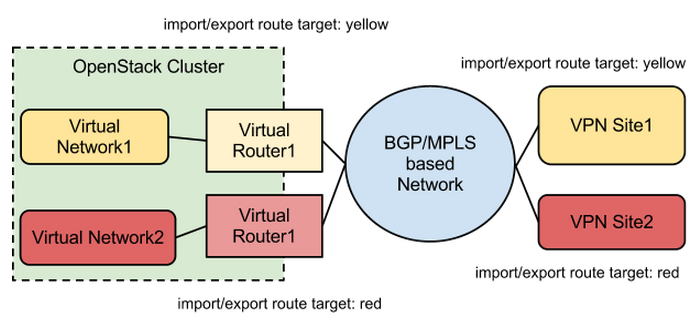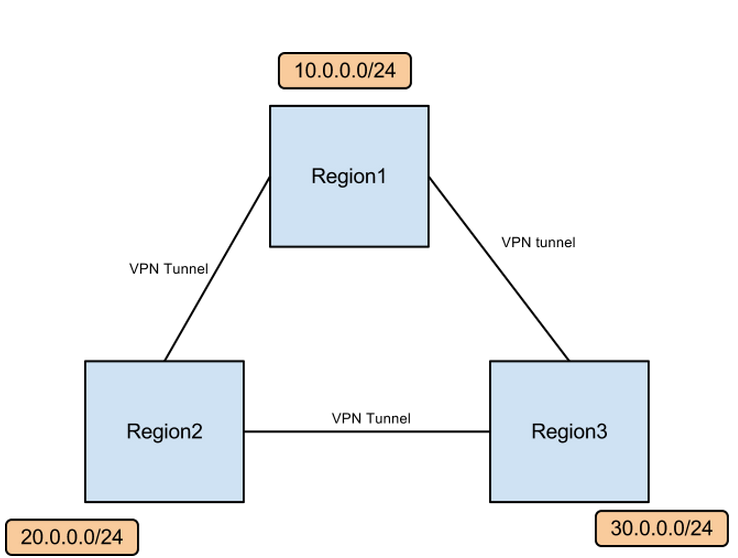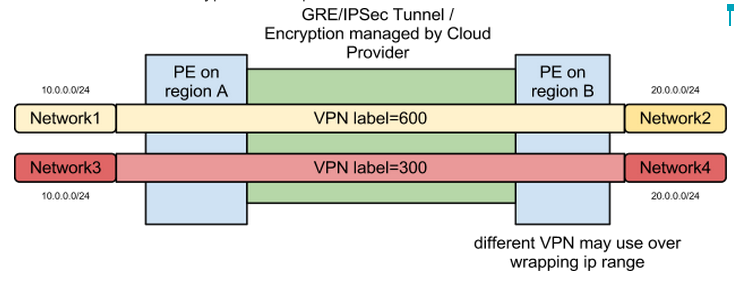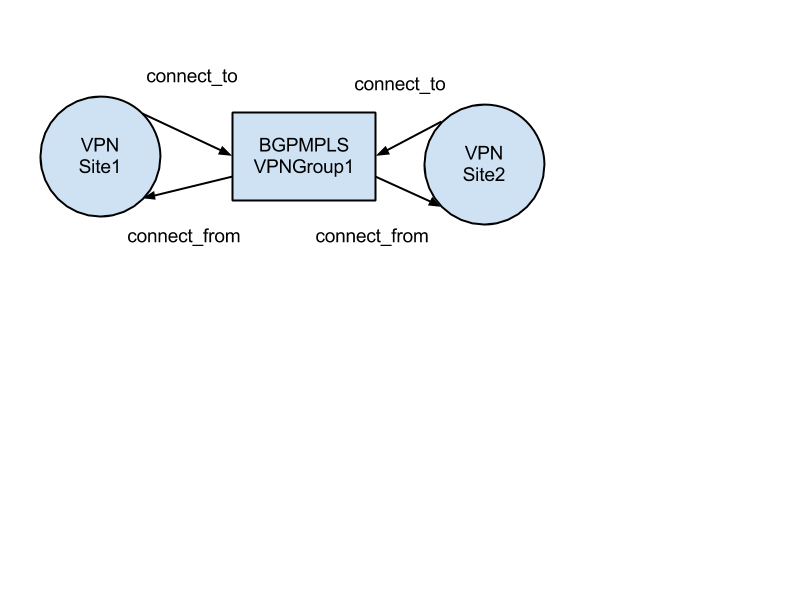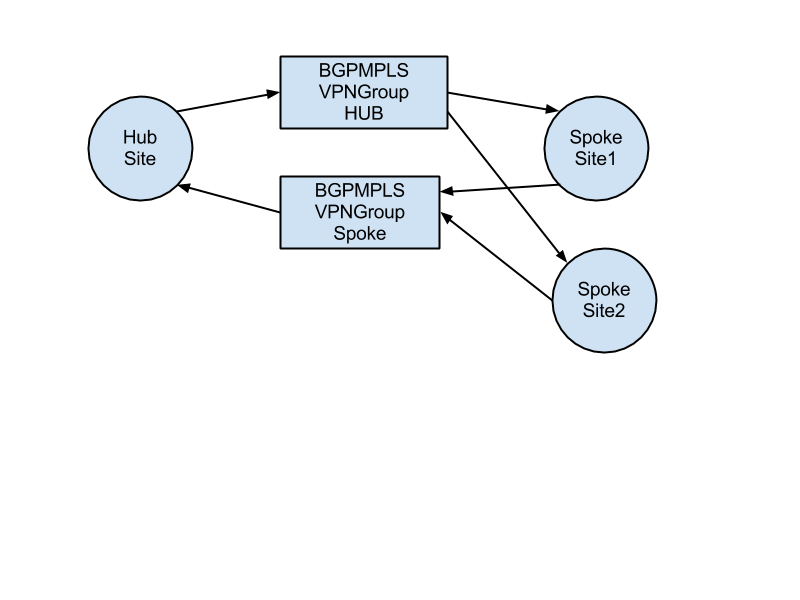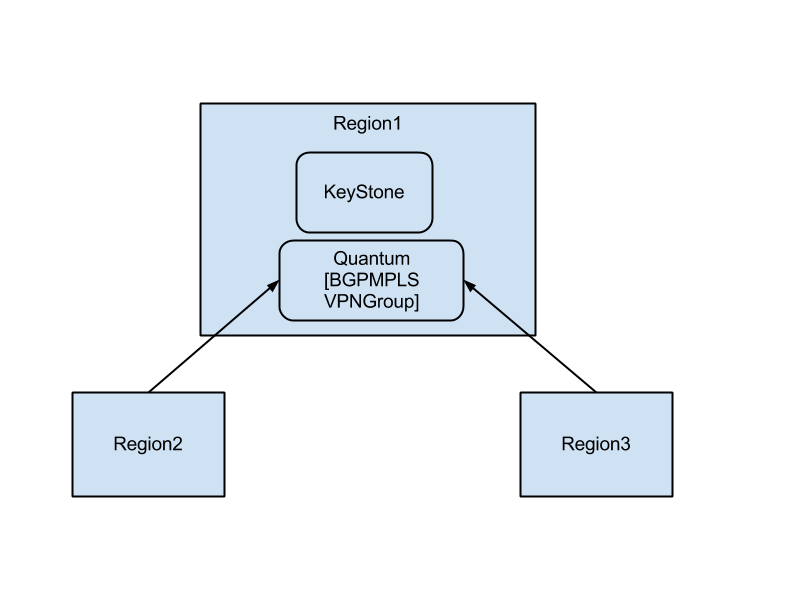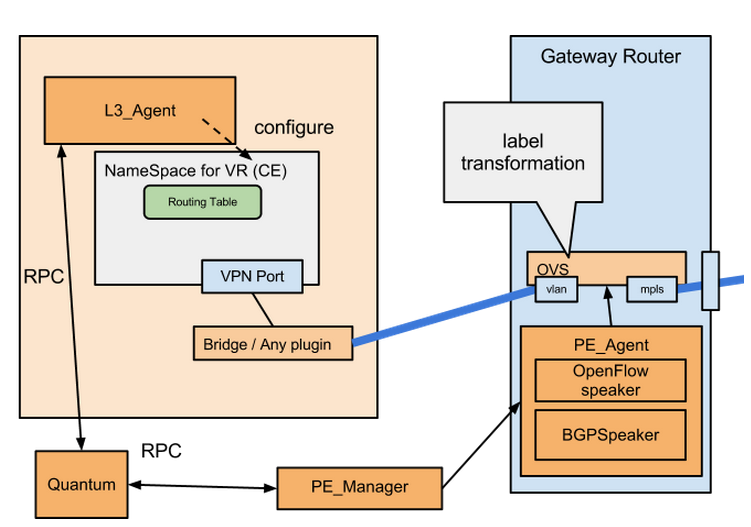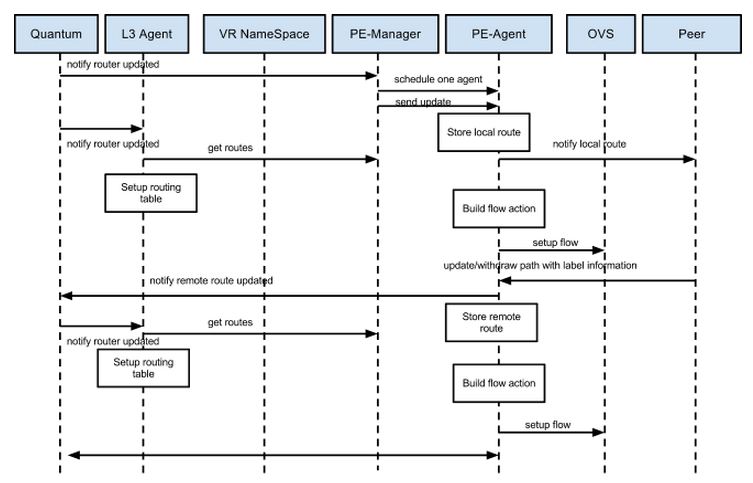Difference between revisions of "Neutron/BGP MPLS VPN"
(update based on service insertion model) |
(define connected_subnet attribute as subnet resource) |
||
| Line 35: | Line 35: | ||
Tenant parameter | Tenant parameter | ||
| − | # router: | + | # router: ID of the router which will be connected with VPN. |
| − | # connected_subnet: Subnet which will connect virtual router and PE router. | + | # connected_subnet: ID of the Subnet which will connect virtual router and PE router. |
# local_prefixes = [10.0.0.0/24] list of prefix which will be exposed | # local_prefixes = [10.0.0.0/24] list of prefix which will be exposed | ||
# remote_prefixes =[20.0.0.0/24] list of imported prefix ( if this value is null, l3-agent setup all recieved routes | # remote_prefixes =[20.0.0.0/24] list of imported prefix ( if this value is null, l3-agent setup all recieved routes | ||
| Line 165: | Line 165: | ||
Create virtual router | Create virtual router | ||
quantum router-create router1 | quantum router-create router1 | ||
| + | |||
| + | Create external network | ||
| + | quantum net-create net-ext --router:external=True | ||
| + | |||
| + | Create subnet in the external network | ||
| + | quantum subnet-create net-ext 50.0.0.0/24 --name=subnet-ext | ||
Insert BGP VPN Service to the router | Insert BGP VPN Service to the router | ||
| − | quantum router-service-insert --type=bgpmplsvpn --route_distinguisher=6800:1 --router=router1 --connected_subnet= | + | quantum router-service-insert --type=bgpmplsvpn --route_distinguisher=6800:1 --router=router1 --connected_subnet=subnet-ext --local_prefixes list=true 10.0.0.0/24 20.0.0.0/24 --remote_prefixes list=true 30.0.0.0/24 40.0.0.0/24 --connect_to list=true $GROUP --connect_from list=true $GROUP |
== Horizon Requirements: == | == Horizon Requirements: == | ||
Revision as of 04:46, 13 April 2013
Contents
Scope:
This BP implements partial RFC4364 BGP/MPLS IP Virtual Private Networks (VPNs) support for interconnecting existing network and OpenStack cloud, or inter connection of OpenStack Cloud.
Use Cases:
Use case 1: Connect Quantum Virtual Network with Existing VPN site via Virtual Router In this case, we connect virtual networks in the quantum to the existing VPN site via Virtual Router. Each route will be dynamically exchanged using BGP.
Use case 2: Interconnect multiple OpenStack regions There are 3 regions which is interconnected via some VPN method (eg, IPSec) in the diagram below. All regions are managed by only one operator. 10.0.0.0/24 is on Region1 and 20.0.0.0/24,30.0.0.0/24 are so on. Using ibgp, we can connect virtual networks on any cluster on efficient manner.
The diagram below shows encapsulation of packet on this usecase. Each region connected with IPSec tunnel w/ Encryption. Each packet will labeled with MPLS.
Data Model Changes:
BGPMPLSVPNService (new resource)
based on service insertion model
Admin only parameter
- route_distinguisher = type:administrator:assigned
- type=0 administrator=16bit : assigned = 32bit
- type=1 administrator=IPaddress: assigned = 16bit
- type=2 administrator=4octet AS Number: assigend = 16 bit
Note Default value automatically assigned with type=0 format
Tenant parameter
- router: ID of the router which will be connected with VPN.
- connected_subnet: ID of the Subnet which will connect virtual router and PE router.
- local_prefixes = [10.0.0.0/24] list of prefix which will be exposed
- remote_prefixes =[20.0.0.0/24] list of imported prefix ( if this value is null, l3-agent setup all recieved routes
- connect_from = [VPNG_ID1,VPNG_ID2,VPNG_ID3] (list of vpn group )
- connect_to = [VPNG_ID1, VGPN_ID2] (list of vpn group )
Note: default value of connect_from/connet_to route target will all vpns in the list on create
BGPVPNGroup (new resource)
shows list of route targets assigned for each tenant
- id:
- name:
- tenant_id:
- route_target (*) asn16bit :32bit integer or ipv4:16bit integer (admin only)
(*) Only admin user can specify route target, otherwise it will be automatically assigned.
BGP Routes (new resource) Admin Only
- prefix
- nexthop
- rt
- rd
- router_id
- paths (list of paths sorted by score)
Sub attribute of paths
- nexthop,
- as_path,
- multi_exit_disc,
- local_pref,
- origin,
- labels,
- client,
- local
BGP Peers (new resource) Admin only
- id
- neighbor_ip
- remote_as
- status = (ACTIVE|DOWN)
- admin_status=True|False
- pe_agent
Model of BGPVPNGroup
BGPVPNGroup correspond to Route target internally. (see RFC4364 4.3.5. Building VPNs Using Route Targets). In this diagram, VPN site1 and Site2 can talk each other.
You can also support hub-spoke model, shown in the diagram. In this case Hub Site and Spoke Site1 and Site2 can reach each other, however Spoke Site1 and Site2 is unreach.
BGPVPNGroup will be managed by Network provider. We will share one BGPVPNGroup server in different data centers. In the diagram below, Region2, and Region3 uses BGPVPNGroup DB in Region1, thus they can assign BGPVPNGroup by consistent manner between several regions.
Note, this BGPVPNGroup assignment has driver architecture. For same case, Network operator have already managing mapping to BGPVPNGroup (RT) and tenant. Fot that case,the Network operator can implement a driver which provides there own BGPVPNGroup (RT) and tenant mappings.
Implementation Overview:
The diagram below shows implementation overview. Quantum Server and BGP Peer will be connected via BGP speaker process. There are no Open Source project which support BGP/MPLS vpn yet, we will also open our erlang version implementation of bgp speaker and PE router which will implemented partial RFC. But this design is not limited to our implementation, and API itself can be connected any MPLS/PE router implementation. BGP Speaker send update of Router configuration for BGP peer, and get routes from Peer. Our PE also set up vlan to mpls transformation and adding or removing mpls labels for each outgoing packet. Note that we are not talking about transport labels and that transport will be either p2p (option B ASBR) or GRE encapsulation will be used.
The sequence below shows how each component will talk each other.
Scheduling / HA
PE Agent is scheduled by PE Manager. When agent downs, PE Agent scheduler will reschedule bgp network for another agent. PE Scheduler itself has bulid-in HA (ACT - Sby ) support for managing PE schedule. PE Manager also dispatch message from Quantum to specific PE-Agent.
Configuration variables:
quantum server configuration
- my_as
- bgp_speaker ip and port: specifies bgp speaker which will be interconnected
- route_target_range: route target range for rt assignment
- route_distinguisher_range: rd range for rd assignment
- bgpvpngroup_driver: driver for managing route target
- bgpspeaker_driver (*)
- driver to configure bgp speaker
You can use db or quantum value for bgpvpngroup_driver
- bgpvpngroup_driver=db using local db
- bgpvpngroup_driver=quantum use another quantum server
bgpspeaker configuration
- my_as
- bgp_identifier
- neighbors
API's:
CRUD rest api for each new resources
Plugin Interface: Implement above data model
Required Plugin support: yes
Dependencies: BGPSpeaker
CLI Requirements:
Create bgpvpngroup
quantum bgpvpngroup-create --name test --route-target 6800:1
List bgpvpngroup
quantum bgpvpngroup-list -c id -c name -c route_target
Set bgpvpngroup id to env variable
GROUP=`quantum bgpvpngroup-list -c id -c name -c route_target | awk '/test/{print $2}'`
Delete bgpvpngroup
quantum bgpvpngroup-delete <id>
Create virtual router
quantum router-create router1
Create external network
quantum net-create net-ext --router:external=True
Create subnet in the external network
quantum subnet-create net-ext 50.0.0.0/24 --name=subnet-ext
Insert BGP VPN Service to the router
quantum router-service-insert --type=bgpmplsvpn --route_distinguisher=6800:1 --router=router1 --connected_subnet=subnet-ext --local_prefixes list=true 10.0.0.0/24 20.0.0.0/24 --remote_prefixes list=true 30.0.0.0/24 40.0.0.0/24 --connect_to list=true $GROUP --connect_from list=true $GROUP
Horizon Requirements:
- Extended attribute configuration page
- show dynamic routes
Usage Example:
TBD
Test Cases:
Connect two different openstack cluster (devstack) with BGP/MPLS vpn

